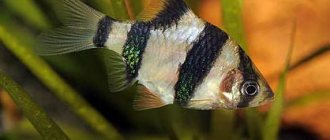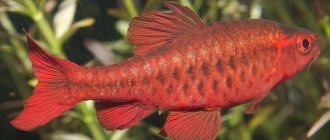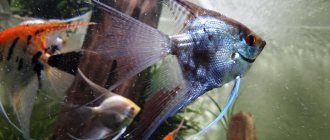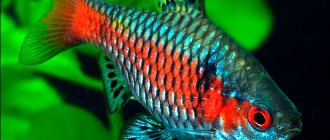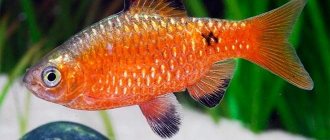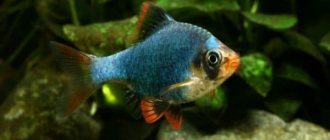Bright, active, hardy barbs are an excellent addition to any aquarium with appropriately sized inhabitants. These lively, colorful, cheerful fish are able to adapt to various conditions. Barbs are a good choice for beginners because they are unpretentious in maintenance and food. Reproduction of barbs is not a very difficult process, even an amateur can do it. Requires little more effort and planning than breeding viviparous guppies. Guppies give birth to fry, and barbs lay eggs.
Most of this species are small in size, but they need a lot of space to swim. Some varieties love plants and use them as shelter. Almost all types of barbs prefer soft, neutral water that is well aerated.
Since these are very energetic fish, they can be intolerant and noisy for the calmer and slower inhabitants of the aquarium, so it is recommended to keep them in numbers of 6 or more individuals. Barbs are not the best neighbors for fish with long fins.
Description of popular types
There are a large number of types of barbs for the aquarium, here are some of the most popular:
Sumatran barbs (Puntigrus tetrazona)
Also called Tiger barbs, these are strikingly beautiful tropical fish. Its arrow-shaped body is luminous, gold-plated, and has four black vertical stripes. The caudal fin is highlighted with bright orange markings above and below, making the colorless middle part almost invisible. There is an orange color on the pectoral, pelvic and anal fins. In an aquarium, fish easily grow up to 5 cm, some individuals can reach 7 cm.
Fire barb (Puntius conchonius)
The fish are red and gold in color, reaching a size of 15 cm. They feel good in schools with two females for each male. They are prone to aggression if not kept in a group. One of the most popular and affordable fish for aquarium lovers. This is an active fish with a peaceful nature and bright colors. Both sexes have black speckles on their fins and sides.
Black-striped ruby barb (Puntius nigrofasciatus)
It gets its name because the female Black Ruby Barb turns a bright, deep red color when it reaches breeding age. They are peaceful fish measuring 6.5cm in size and are easy to care for and should be kept in groups of five or more. Well compatible with tiger barb.
Barbus Denisonii (Puntius denisonii)
This variety reaches a size of 15 cm. A black line runs along the entire silvery body, which contrasts with a shiny red line that runs just above the black one, reaching the middle of the body.
The dorsal fin is also bright red and the caudal fin is striped with black and yellow stripes. This is an active, schooling species that requires a lot of swimming space. It is better to keep with neighbors of the same size. In recent years, a gold variant has emerged that has a red stripe but no black stripe.
Golden or Chinese barb (Puntius semifasciolatus)
It reaches 7.5 cm in size. The bright yellow color of the body is the result of a mutation. It was artificially bred by Thomas Schubert in the 1960s. The natural color of this fish is green, but it is rarely found commercially due to the popularity of the gold form. Almost all specimens currently sold were created in captivity. There are several other color variations, such as albino and tricolor.
Barb (Barbonymus schwanenfeldii)
The largest representative of barbs. This is a gregarious species, reaching 35 cm in length. Should only be kept in large aquariums. A distinctive feature is the white and black stripes on the outer lateral rays of the forked caudal fin and the white and black end of the dorsal fin.
Four-line barb (Puntius johorensis)
An attractive and peaceful species, this species is not often found on sale. Unlike many members of this family, it has horizontal stripes rather than vertical ones. Because of this feature, in Western countries it received the name Zebra Barb. Although they are not very large (12 cm), they are quite active and therefore require a larger aquarium for swimming.
Preparing the spawning tank
First you need to prepare a spawning area where reproduction will take place. Take a rectangular glass aquarium with a volume of 10-20 liters, pouring water into it to a height of 25 cm. The bottom should have an area of 0.5 square meters. Do not use glass jars or plastic containers.
Before adding fish to it, the tank should be washed in running water using baking soda. Rinse its walls 4-5 times under running water. Next, fill the spawning tank with fresh infused water (which has been infused for 3-4 days), taken earlier from the tap. Fill 90% of the volume of the spawning aquarium with infused water, and 10% of the “old” water from the general aquarium. Place the separator mesh at a level of 2.5 cm from the bottom. Above it, place Java moss or pinnate and other small-leaved plants.
The water temperature in the spawning tank should be 26-28 o C, water hardness 15-18 dH, acidity 6.8 pH. Lighting – 0.5 W fluorescent lamps. Once the spawning tank is ready, fish can be released into it.
See how to breed Sumatran barbs at home.
How to choose manufacturers?
It will not be possible to breed Sumatran barbs at home right away if the producers are chosen incorrectly. This means that there may be unpleasant cases associated with the unpreparedness of males and females for reproduction. The male can drive the female to death, at a time when her eggs have not yet matured. Sometimes the female waits for spawning, but the male does not enter into mating games.
To avoid such cases, choose plump female Sumatran barbs, with an enlarged, swollen abdomen, which has an almost rectangular outline. The female should be introduced into the spawning ground first, after 1-2 days the male can be placed next to her. The breeding male is selected to be of medium size, with the most frisky character and bright body color. 2 days before spawning it is removed from the common tank.
Observe the behavior of the male and female. If they are chasing each other, conflicts arise between them - then one of the manufacturers should be replaced. To avoid severe stress, floating plants can be added to the aquarium. Due to the resulting shock, the female may release her eggs prematurely. It is advisable to place a calm male with her. To ensure that you are able to breed barbs at home, it is better to keep a large school of fish (5 males and 10 females), from which you can choose good producers.
Watch the mating displays of Sumatran barbs.
Spawning process. Caviar care
Spawning of barbs occurs quickly and violently, lasting 1-1.5 hours. One fertile female can produce 800-1000 eggs. After breeding, the producers should be removed. Then you can pump oxygen (aeration) into the spawning tank and cover it with dark paper or cloth.
After 3-4 hours, you can sort the eggs - remove the net and plants from the aquarium, carefully shaking off the eggs from them. Next, drain almost all the water from the container, leaving 3 liters in it. Then you need to drain the remaining water and caviar from the spawning tank into a clean 3-5 liter jar.
If fertilization is successful, almost all eggs will be alive. Live caviar is transparent, and dead caviar is white. To prevent live eggs from dying, they must be removed from the container using a pipette and placed in a flat cup with water from the spawning tank. After this, add fresh infused water to the jar (in proportions: half old, half new). Organize a good supply of oxygen in the jar, add methylene blue, and place the container in a dark place, or shade its walls with light-proof material. Monitor the development of the eggs and remove the white ones with a pipette. Once a day, replace 10% of the water with fresh water.
After 24 hours, larvae will appear from the eggs, and after another 3-4 days they will become swimming fry that will begin to look for food on their own. If there are a lot of fry, transplant them into a spacious aquarium with a volume of 10-20 liters (possibly in the previous spawning tank), pour infused water into it at a level of 15 cm and old water from a jar. Starter food – live dust, egg yolk (hard-boiled).
After a few days, the fry are allowed to be given Artemia nauplii and specialized food for barb fry. The fry grow rapidly, at the age of 1 month they will be 1 cm in length. Spawning of other species of medium-sized barbs and care of fry proceeds in the same way.
Barbs become sexually mature at eight months. A female ready for spawning has a wider lower abdomen and a swollen anus. It must be borne in mind that males mature 1-1.5 months later than females.
A small 20 liter aquarium is required for spawning. Plants with small leaves are placed at the bottom, and a separator net is installed above them (otherwise the barbs may eat the eggs). The water in this container should stand for about three days. One corner of the spawning aquarium is darkened, and the other is left illuminated by a 40W lamp; aeration must be turned on. The day before spawning, the producers are no longer given food. The pair is placed in the spawning tank in the evening, the water temperature is raised to 28-29 ºС. In the morning, spawning should occur. This occurs in a shaded area, above the plants. The female can lay up to 800 eggs.
At the end of spawning, the spawners are removed, and the aquarium with eggs is shaded. After about two days, the larvae appear, and on the third day they begin to swim. Now you can remove the darkening and reduce aeration. You can feed the fry “live dust”, Artemia nauplii every 3 hours. For the first week, the container with the fry should be illuminated around the clock, and the temperature should be reduced to 24 ºС.
After 2 weeks, the spawned female is replanted for spawning, only with another male. Otherwise the female will have a cyst.
How do barbs spawn?
Let's consider the reproduction of this species using the example of Sumatran barbs.
Barbs usually spawn in a community aquarium; this is useful for removing eggs from females. If they do not spawn for a long time, they may die . When they spawn in a community aquarium, all the eggs and fry will be eaten. To preserve the fry, fish need to be bred in a separate aquarium.
If you want to get serious about breeding Sumatran barbs, purchase about six individuals and quarantine them in a 100-liter aquarium. Experienced aquarists advise keeping the ratio of the number of males to the number of females 1:2.
Breeding barbs at home does not require special preparation, but you need to know some features.
When choosing barbs in a pet store, carefully examine each specimen offered by the seller. Examine the color of the fish, make sure that the fins are not damaged. Once in the quarantine tank, the dominant ones will quickly establish a rank order. As a rule, males show more aggression. Later it will be noticeable that the two individuals are interested in each other. If there are several interested males, choose the best and most colorful one.
Reproduction
The selection of parents of future fry is carried out in accordance with the following criteria:
- The female has reached sexual maturity (6–9 months);
- The behavior is active, but not aggressive (otherwise the mother will destroy the offspring);
- Pedigree also plays a key role: there should be no marriages or mutated fry among previous broods. Otherwise, the risk of having defective offspring increases.
As soon as the female is ready for spawning, her appearance will change slightly: the abdomen will become rounded and with slight pressure on the abdomen, drops of milk are released from the anus.
It is important to remember that the male reaches sexual maturity 1-1.5 months later than the female!
It is necessary to constantly monitor how the fish spawn in order to detect signs of possible aggressive behavior of the parents in time. As a rule, the eggs are spawned a month after the parents are placed in a separate aquarium.
After 2 days, tiny larvae hatch from the eggs, which become fry on the 4th day.
How to distinguish a female from a male
We determine gender as follows:
It is not difficult to distinguish a female from a male: females are larger than males, have a full abdomen and a calm coloration.
- males are usually smaller and often brighter than females;
- the male's body is small and thin;
- females are distinguished by a full outline and a slightly softer color in the nostril area.
These aquarium fish become mature at the age of 7-8 months, that is, they are already ready to produce offspring. It is easy to determine if a female is pregnant - her abdomen will look very swollen. If the fish cannot spawn for a long time, it may die.
Possible problems
The process of breeding Sumatran barbs can be accompanied by diseases:
- redness of the gills (the bases of the fins);
- the appearance of mucus on the scales, sticking of fins, lethargy.
Such symptoms are possible due to infection of the fish with ectoparasites and are eliminated by treating the fish with antibiotics, methylene blue, and placing it in salt baths for a short time. During the treatment period, the barb is left in the spawning area.
When planning to breed Sumatran puntius and obtain offspring from them, purchase individuals of three months of age, when it is already possible to distinguish a female from a male. Please note that it is advisable to buy the number of male and female fish in a ratio of 2:1, respectively.
- Related Posts
- Rules for keeping the bream barb
- Luminous and unique: all about the red Sumatran barb
- The velvety splendor of the black barb: features and conditions of detention
Preparation and spawning
Reproduction of Sumatran leopards is often complicated by the fact that these fish are bad parents. They eat their eggs, sometimes during spawning, so removing the eggs or adults is essential for the survival of the fry.
1 way
Place the pair in a 75 liter water tank, but smaller sizes are also possible. The temperature must be at least 25°C. Use a powerful sponge filter. Provide good aeration.
If you plan to remove eggs from the aquarium after spawning, then it is better to leave the bottom bare - this makes it more convenient to collect the eggs in a plastic container with a long handle.
If the parents are to be removed after the barb spawning is over, it is recommended to install a special separator mesh on the bottom to prevent them from eating the eggs.
A pair that is planning to breed should be fed shortly after being placed in a separate tank. It is advisable that the food be of animal origin, such as shrimp. There should be enough of it so that there is no competition.
After a day of acclimatization, install a tank divider, with which the space will be divided into two parts. The material used for the partition is plexiglass with drilled small holes. Such a barrier will allow for sufficient water circulation, but will not allow fish access to each other.
For 5 days, you should change 10% of the water daily, then the separator is removed. The couple will willingly interact with each other. Reproduction of barbs can last 1-2 hours. While the female lays eggs, the male follows her and fertilizes the eggs.
After the process is completed, either the eggs or the parents should be removed.
Video: barb spawning
Method 2
Preparation of the spawning area is carried out as follows:
- Half of the water in a 15-20 liter container should be from the general aquarium, and half should be fresh.
- It is recommended to set the water level at 15 cm.
- The water temperature is not lower than 25 °C.
- Small-leaved plants such as cabomba are placed at the bottom, pressed down with a weight so that they do not float up.
- Before spawning, males and females are kept in different aquariums and receive a sufficient amount of high-quality food.
You can also place a bunch of moss on the bottom.
To spawn Sumatran barbs, the male and the fullest female are transplanted into a specially prepared aquarium in the evening. In the morning, dim, diffused light is turned on. The male begins to pursue the female and soon you will be able to see the eggs, which she can lay up to 600 eggs. The male following her fertilizes them. You can watch the fish breed for about an hour, then the couple loses interest in each other. The fish begin to look for eggs and eat them. This is a signal to put them away.
After removing the parents, it is recommended to add a small amount of anti-fungal agent, such as methylene blue, to the water to prevent the eggs from spoiling . If this is not done, the fungus will first cover the unfertilized eggs, and then the healthy ones. Dead eggs will turn white and should be removed.
Methylene blue (methylene blue) is a medicine with disinfecting properties, used in aquarium farming.
Preparing for reproduction at home
It is advisable to begin preparing fish for reproduction before the onset of puberty in the spring-summer period: when the young fish reach the age of 4-5 months, select large-sized specimens with bright colors and raise them in a separate tank with a water temperature of 23-24 ⁰C, regular cleaning and aeration. It is important to avoid excess nutrition.
Spawning of Sumatran barbs occurs several times with an interval of 7-9 days; at this time, place the fish separately. Maintain a break between spawnings of no more than two weeks, as cysts may form in females that have not laid eggs.
Sexual maturity of fish occurs at 6-8 months (females mature 1-1.5 months earlier than males), from this time begin preparations for spawning. For Sumatran barbs, placing male and female individuals in separate tanks is not mandatory , but in order for females to collect eggs in a calm environment, the procedure is desirable.
How to determine the sex of fish?
Distinctive sexual characteristics of barbs (appear by the age of three months):
- the female has a larger size and a rounded abdomen, the male’s body is angular;
- the scales of female individuals are faded in color, the color of the “cavaliers” is bright;
- the caudal, dorsal and pectoral fins in males have bright orange-red stripes, in “girls” the color of the external thoracic organ is reddish, the caudal and dorsal fins are transparent;
- “boys” are characterized by a reddish tint to the front of the head.
Manufacturer selection criteria:
- inspect the fish: specimens with curved backs, damaged, deformed fins, or deviations from the standard color will not be suitable;
- the optimal fish size is medium;
- The animal's activity is moderate, without aggression.
12-14 days before the start of spawning, place the fish in fish tanks (females separately from males).
To adapt your fish to a new environment, follow the following conditions:
- The water temperature should initially be 22-25 ⁰С, as in a general aquarium. Gradually increase the indicator to 26-28 ⁰С.
- Acidity when placing barbs in a separate aquarium is 7 pH, within 3-4 days bring it to a level of 6.5 by adding tap water (settled) or using sodium bicarbonate and monitoring the level with an electronic tester, litmus paper or special reagents.
- For the entire period of separate keeping of males, feed protein foods (tubifex, barkworm, bloodworms), and females - plant foods.
By the end of the preparatory stage, the belly of females becomes swollen and spreads out to the sides, and the anus swells. An important point about keeping fish separately is that if individuals are kept in different aquariums for too long, the males become aggressive, and the females may develop a cyst, which will lead to the death of the fish.
Feeding the fry
In 2-3 days the larvae will hatch, and after another three they will turn into fry and begin to swim freely. At this moment they begin to be fed. When the yolk sacs are used up, feed the fry small amounts of ciliates, daphnia and crushed shrimp three times a day. Start with small products such as ciliates, “live dust”. Once the juveniles are old enough, start feeding them shrimp meat. The amount of food supplied is as much as the fry can eat in a few minutes.
